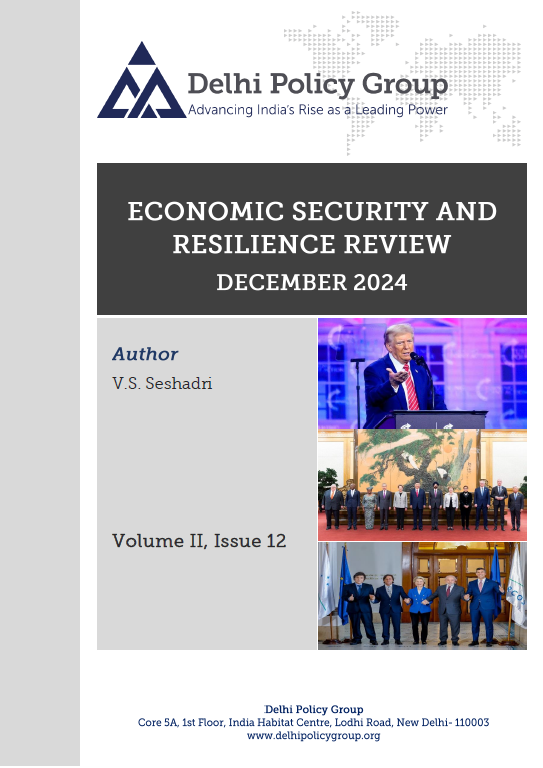Economic Security and Resilience Review
Date: January 04, 2025
Further to the assessment in the last issue of ESRR of the possible implications of a Trump-2 administration for India’s economic security and resilience, this issue draws attention to the President-elect’s recent statements about India’s high tariffs, and how he would be looking at reciprocity as a principle. The ongoing domestic narrative in the US about H1B visas and foreign student work related programmes is also a matter for concern, both for the holders of these authorisations and the businesses benefitting from such skilled worker availability.
This issue highlights China’s plan to proceed with the construction of the world’s largest dam across the Brahmaputra river in an ecologically sensitive area of eastern Tibet, which could put at risk the economic security of downstream reaches of the river spreading across the expanse of north east India and Bangladesh.
Three significant developments during the month related to FTAs are outlined in this issue. After ten rounds of negotiations between the Indian and Australian teams negotiating the bilateral CECA, stock taking is taking place to chart way forward. India’s Commerce Minister Piyush Goyal has conveyed to EU envoys in New Delhi that there is need for political direction for the India-EU FTA negotiations to make further progress, particularly in relation to sustainability issues. The finalisation of the EU-MERCOSUR FTA text may be of considerable relevance to India’s own negotiations with the EU.
China’s President Xi Jinping met with the heads of ten major international economic organisations on December 10, 2024, and presented to them China’s perspectives on current international economic developments, including on US-China relations. In response to its slowing economy and an adverse external environment, China announced policy stimulus initiatives during the month, signalling a ‘moderately loose’ monetary policy.
The month also witnessed the further tightening of US export controls and related sanctions targetting China, aimed at its capacity of making advanced semiconductors. US also initiated investigations on anti-competitive practices by China in relation to legacy semiconductor chips used in a multitude of sectors, from automotives to medical devices. China in turn took retaliatory actions against the US, and launched an anti-monopoly investigation against the US company Nvidia.
Finally, this issue covers other developments during the month, including the Indian Supreme Court’s ruling against the Swiss company Nestle, the imposition of tariffs by the US on solar panels from South East Asian countries for their Chinese content, and the announcement by China’s largest battery maker CATL and the European carmaker Stellantis to set up a Euro 4.1 bn lithium battery plant in northern Spain.
To read this issue of the ESRR, Vol. II, Issue 12, please see the PDF attached
This issue highlights China’s plan to proceed with the construction of the world’s largest dam across the Brahmaputra river in an ecologically sensitive area of eastern Tibet, which could put at risk the economic security of downstream reaches of the river spreading across the expanse of north east India and Bangladesh.
Three significant developments during the month related to FTAs are outlined in this issue. After ten rounds of negotiations between the Indian and Australian teams negotiating the bilateral CECA, stock taking is taking place to chart way forward. India’s Commerce Minister Piyush Goyal has conveyed to EU envoys in New Delhi that there is need for political direction for the India-EU FTA negotiations to make further progress, particularly in relation to sustainability issues. The finalisation of the EU-MERCOSUR FTA text may be of considerable relevance to India’s own negotiations with the EU.
China’s President Xi Jinping met with the heads of ten major international economic organisations on December 10, 2024, and presented to them China’s perspectives on current international economic developments, including on US-China relations. In response to its slowing economy and an adverse external environment, China announced policy stimulus initiatives during the month, signalling a ‘moderately loose’ monetary policy.
The month also witnessed the further tightening of US export controls and related sanctions targetting China, aimed at its capacity of making advanced semiconductors. US also initiated investigations on anti-competitive practices by China in relation to legacy semiconductor chips used in a multitude of sectors, from automotives to medical devices. China in turn took retaliatory actions against the US, and launched an anti-monopoly investigation against the US company Nvidia.
Finally, this issue covers other developments during the month, including the Indian Supreme Court’s ruling against the Swiss company Nestle, the imposition of tariffs by the US on solar panels from South East Asian countries for their Chinese content, and the announcement by China’s largest battery maker CATL and the European carmaker Stellantis to set up a Euro 4.1 bn lithium battery plant in northern Spain.
To read this issue of the ESRR, Vol. II, Issue 12, please see the PDF attached



